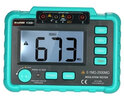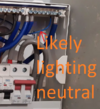- Joined
- 27 Jan 2008
- Messages
- 27,551
- Reaction score
- 3,330
- Location
- Llanfair Caereinion, Nr Welshpool
- Country

If the fault was a borrowed neutral there would be two circuits which are not RCD protected, since only one we can discount that. Other cause is where electronic switches are fitted which need a neutral, and some one has used an earth instead, so I would look for any dimming switches.
The next is the fixing screws in the switch pinching the neutral, this needs a tester, and removing all switches, there are two ways to test, one is use an insulation tester the other a clamp on ammeter
the other a clamp on ammeter  both the ones I show cost £35 when I bought them, and need some skill to use them, and also likely some time, what we need to do as electricians is:-
both the ones I show cost £35 when I bought them, and need some skill to use them, and also likely some time, what we need to do as electricians is:-
1) Turn all lights off and remove bulbs, disconnect neutral in consumer unit, and test to see if line or neutral, this can half the tests further on.
2) Guess approx half way, and test both sides.
3) Guess approx half way in faulty side, and again test both side.
And so on, one can be lucky, but is can also take a long time.
I did it with daughters house, and found a fixing screw shorting on a neutral wire where the installer had caught the installation when stripping with a knife. Mothers house I aborted as found the wiring was rubber, and simply needed a rewire, and it was better not to disturb until ready for a rewire.
The problem is the bathroom. The use of plastic pipe can result in the bonding being broken, and it must either be fully bonded or RCD protected, and if neither fully bonded or RCD protected it will fail an EICR.
As said putting the clamps around the meter tails you can see the total leakage. I find this is a good start point, my tails show about 22 mA total leakage, which over 14 RCBO's is not a problem, but not really going to work with just two RCD's. However your paperwork says zero so it would seem a direct short rather than overall leakage.
I suppose first thing to look at is any outside lights, but one would have expected the electrician to have looked at that.
The next is the fixing screws in the switch pinching the neutral, this needs a tester, and removing all switches, there are two ways to test, one is use an insulation tester
 the other a clamp on ammeter
the other a clamp on ammeter  both the ones I show cost £35 when I bought them, and need some skill to use them, and also likely some time, what we need to do as electricians is:-
both the ones I show cost £35 when I bought them, and need some skill to use them, and also likely some time, what we need to do as electricians is:-1) Turn all lights off and remove bulbs, disconnect neutral in consumer unit, and test to see if line or neutral, this can half the tests further on.
2) Guess approx half way, and test both sides.
3) Guess approx half way in faulty side, and again test both side.
And so on, one can be lucky, but is can also take a long time.
I did it with daughters house, and found a fixing screw shorting on a neutral wire where the installer had caught the installation when stripping with a knife. Mothers house I aborted as found the wiring was rubber, and simply needed a rewire, and it was better not to disturb until ready for a rewire.
The problem is the bathroom. The use of plastic pipe can result in the bonding being broken, and it must either be fully bonded or RCD protected, and if neither fully bonded or RCD protected it will fail an EICR.
As said putting the clamps around the meter tails you can see the total leakage. I find this is a good start point, my tails show about 22 mA total leakage, which over 14 RCBO's is not a problem, but not really going to work with just two RCD's. However your paperwork says zero so it would seem a direct short rather than overall leakage.
I suppose first thing to look at is any outside lights, but one would have expected the electrician to have looked at that.

